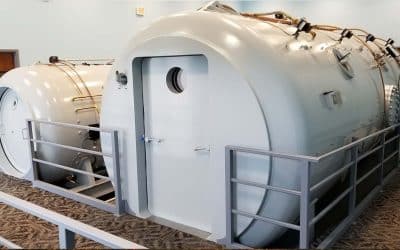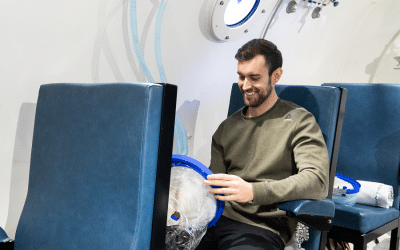Abstract Spinal cord injury (SCI) is a serious neurological disease without efficacious drugs. Anti-apoptosis and suppressing dendritic/synaptic degeneration in the anterior horn are essential targets after SCI. Previous studies found that hyperbaric oxygen therapy...
Spinal Cord Injuries
Hyperbaric Oxygen Therapy (HBOT) Research for Spinal Cord Injuries
Evaluation of hyperbaric oxygen therapy for spinal cord injury in rats with different treatment course using diffusion tensor imaging.
Animal study. To evaluate the efficacy of hyperbaric oxygen (HBO) therapy for spinal cord injury (SCI) in rats with different treatment course using diffusion tensor imaging (DTI). Hospital in Fuzhou, China. Fifty adult Sprague-Dawley rats were grouped as: (A) sham-operated group (n = 10); (B) SCI without HBO therapy group (n = 10); (C) SCI with HBO therapy for 2 weeks (SCI+HBO) group (n = 10); (D) SCI with HBO therapy for 4 weeks (SCI+HBO) group (n = 10); (E) SCI with HBO therapy for 6 weeks (SCI+HBO) group (n = 10). Basso Beattie Bresnahan (BBB) scores and diffusion tensor imaging parameters including fractional anisotropy (FA), mean diffusivity (MD), radial diffusion (RD), and axial diffusion (AD) values in the injury epicenter, as well as 2 mm rostral and caudal to the injury epicenter were collected and analyzed 6 weeks post-injury.
Effect of hyperbaric oxygen therapy on HMGB1/NF-κB expression and prognosis of acute spinal cord injury: A randomized clinical trial.
Although there are reports of the beneficial effects of hyperbaric oxygen (HBO) therapy in experimental settings, there are few clinical trials of HBO therapy for acute spinal cord injury (SCI). We investigated the effect of HBO in acute SCI by measuring plasma high mobility group box 1 (HMGB1) and nuclear factor kappa-B (NF-κB) levels, and by monitoring changes in electromyogram F-persistence (the percentage of discernible F-waves) and F-chronodispersion (the difference between minimal and maximal latency).
A case report of a 4-year-old boy with intradural spinal cord abscess successfully treated with adjuvant hyperbaric oxygen therapy.
Intradural spinal cord abscesses are rare infections in early childhood and usually result from pre-existing congenital anomalies of the spinal column. The formation of abscess may be the result of hematogenous spread. It is treated by surgical and parenteral antibiotic treatment, but some special cases may require additional treatments. This article presents a 4-year-old male patient who was operated because of spina bifida (meningocele and tethered cord) at the external center, and upon complains of not being able to walk after one month, he was operated with the diagnosis of spinal intradural abscess and referred to us to continue his treatment. The patient was taken into an emergency operation when the spinal magnetic resonance imaging (MRI) taken in our hospital showed a progression of intradural abscess. Due to no regression of neurological deficits in the follow-up and with the risk of a second operation, application of antimicrobial therapy as well as hyperbaric oxygen therapy (HBOT) was planned. At the end of 20 HBOT treatment sessions, the patient started to walk with support and the antibiotic treatment was completed in six weeks.
Hyperbaric oxygen therapy for spinal cord ischaemia after complex aortic repair – a retrospective review.
Complex aortic repair (CAR) carries high rates of debilitating postoperative complications, including spinal cord injury. The rate of spinal cord deficits post-CAR is approximately 10%, with permanent paraplegia in 2.9% and paraparesis in 2.4% of patients. Treatment options are limited. Rescue therapies include optimization of spinal cord perfusion and oxygen delivery by mean arterial pressure augmentation (> 90 mm Hg), cerebrospinal fluid drainage, and preservation of adequate haemoglobin concentration (> 100 g L?). Hyperbaric oxygen therapy (HBOT) has been described in several case reports as part of the multimodal treatment for spinal cord ischemia. HBOT has been used in our centre as adjunct rescue treatment for patients with spinal cord injury post-CAR that were refractory to traditional medical management, and we aimed to retrospectively review these cases. After Research Ethics Board approval, we performed a retrospective review of all post-CAR patients who developed spinal cord injury with severe motor deficit and were treated with HBOT at our institution since 2013. Seven patients with spinal cord injury after CAR were treated with HBOT in addition to traditional rescue therapies. Five patients showed varying degrees of recovery, with two displaying full recovery. One developed oxygen-induced seizure, medically treated. No other HBOT-related complications were noted. Our retrospective study shows a potential benefit of hyperbaric oxygen therapy on neurological outcome in patients who developed spinal cord injury after CAR.
Perfluorocarbon in Delayed Recompression with a Mixed Gender Swine Model of Decompression Sickness.
Perfluorocarbons (PFC) are fluorinated hydrocarbons that dissolve gases to a much greater degree than plasma and hold promise in treating decompression sickness (DCS). The efficacy of PFC in a mixed gender model of DCS and safety in recompression therapy has not been previously explored. Swine (25 kg; N = 104; 51 male and 53 female) were randomized into normal saline solution (NSS) or PFC emulsion treatment groups and subjected to compression on air in a hyperbaric chamber at 200 fsw for 31 min. Then the animals were decompressed and observed for signs of DCS. Afterwards, they were treated with oxygen and either PFC (4 cc · kg-1) or NSS (4 cc · kg-1). Surviving animals were observed for 4 h, at which time they underwent recompression therapy using a standard Navy Treatment Table 6. After 24 h the animals were assessed and then euthanized. Survival rates were not significantly different between NSS (74.04%) and PFC (66.67%) treatment groups.
Neuroprotective effects of hyperbaric oxygen (HBO) therapy on neuronal death induced by sciatic nerve transection in rat.
Recent studies shows that hyperbaric oxygen (HBO) therapy exerts some protective effects against neural injuries. The purpose of this study was to determine the neuroprotective effects of HBO following sciatic nerve transection (SNT). Rats were randomly divided into five groups (n = 14 per group): Sham-operated (SH) group, SH + HBO group, SNT group, and SNT + pre- and SNT + post-HBO groups (100% oxygen at 2.0 atm absolute, 60 min/day for five consecutive days beginning on 1 day before and immediately after nerve transaction, respectively). Spinal cord segments of the sciatic nerve and related dorsal root ganglions (DRGs) were removed 4 weeks after nerve transection for biochemical assessment of malodialdehyde (MDA) levels in spinal cord, biochemical assessment of superoxide dismutase (SOD) and catalse (CAT) activities in spinal cord, immunohistochemistry of caspase-3, cyclooxigenase-2 (COX-2), S100beta (S100ß), and terminal deoxynucleotidyl transferase dUTP nick end labeling (TUNEL) in spinal cord and DRG. The results revealed that MDA levels were significantly decreased in the SNT + pre-HBO group, while SOD and CAT activities were significantly increased in SNT + pre- and SNT + post-HBO treated rats. Attenuated caspase-3 and COX-2 expression, and TUNEL reaction could be significantly detected in the HBO-treated rats after nerve transection. Also, HBO significantly increased S100ß expression. Based on these results, we can conclude that pre- and post-HBO therapy had neuroprotective effects against sciatic nerve transection-induced degeneration.
Hyperbaric oxygen ameliorated the lesion scope and nerve function in acute spinal cord injury patients: A retrospective study.
This is a retrospective study to assess the therapeutic effect of hyperbaric oxygen (HBO) in early treatment of acute spinal cord injury (SCI) using magnetic resonance imaging (MRI) and electrophysiology in diagnosing. Forty acute SCI patients from Sun Yat-Sen Memorial Hospital who were assigned into HBO treatment were included during August 2013 to October 2014.The patients with adverse reactions or contraindications for HBO were assigned as controls. Both of two groups (HBO and Control) received medicine treatment with Urbason, GM-1 and mecobalamine after surgery. ASIA and the Frankel scores were used to evaluate the therapeutic effect of HBO at the 15th and 30th day after HBO treatment by using MRI and electrophysiology features. Significant therapeutic effect of HBO treatment on acute SCI patients was observed compared with the control group (P<0.05). Comparison for ASIA and Frankel scores showed that motor and neurological functions were significantly improved in HBO group at day 15 and day 30 post treatment. MRI images showed that the grade III injury in HBO group was significant lower than the control group. In comparison with the control, the peak of somatosensory evoked potential (SEP) and motor evoked potential (MEP) amplitude increased, the latency was shortened, and the conduction velocity of sensory nerve (SCV) and motor nerve (MCV) was significantly increased in the HBO group (P<0.05). HBO treatment has a great efficacy in acute SCI patients. HBO therapy at early stage of acute SCI is beneficiary to the recovery.
Hyperbaric Oxygen Therapy after Acute Thoracic Spinal Cord Injury: Improvement of Locomotor Recovery in Rats.
The aim of this study was to analyze the effectiveness of hyperbaric therapy (HT) using mild and moderate models of spinal cord injury (SCI). SCI can cause permanent impairment with socioeconomic consequences. The motor deficit occurs by two mechanisms: destruction of neuronal cells and local inflammatory response, resulting in hypoxia. HT acts by increasing oxygen in the injured area. Thoracic laminectomy was performed in 72 female Wistar rats. The MASCIS impactor was used at 12.5 mm (n = 35) and 25 mm (n = 35) of height to perform, respectively, mild and moderate SCI. Muscle strength was assessed through the Basso, Beattie, and Bresnahan scale (BBB) on days 1, 7, 14, 21, and 28 after SCI. The animals were randomized into five subgroups with seven animals each: (1) control group had SCI without HT; (2) HT 30 minutes after SCI; (3) HT 30 minutes after SCI and daily for 7 days; (4) HT 12 hours after SCI; and (5) HT 12 hours after SCI and daily for 7 days. HT was performed at 2.5 atm for 1 hour.



